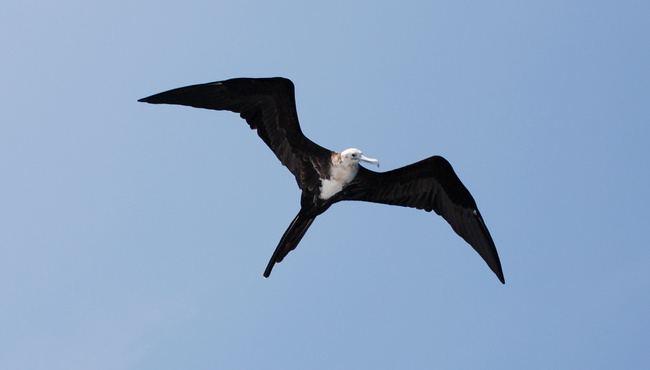Magnificent Frigatebird
Magnificent Frigatebird (Fregata magnificens)Spanish name: Rabihorcado Magno

More about Magnificent-Frigatebird
Habitat
This oceanic bird fishes over tropical coastal waters in Atlantic and Pacific oceans and roosts in coastal trees.
Range
On the Pacific side of the Americas, the Magnificent Frigatebird is present between Baja, California and Peru as well as in the Galapagos; on the Atlantic coast, it lives in the Caribbean and the Gulf of Mexico.
Physical Description
The most abundant species of frigatebirds, the Magnificent Frigatebird is exclusively oceanic, found in all tropical areas of the world. This bird has a distinctive profile, with a deeply forked tail and extremely long, slender and pointed wings. Its solid black form makes a bold outline against the sky, although it also has a faint brown bar across the upper wing, black or brown feet, and a gray bill. The male has a gular pouch (a throat pouch to accommodate large fish) that can be bright pink to red. The female has a grayer gular pouch, a white breast, a paler brown bar on the wing, and orbital skin around the eye that is violet-blue. Juveniles have a white head and breast, a striking pale bar on the wing, and a pale blue bill, orbital skin, and feet.
Interesting Biology
The Magnificent Frigatebird has the lowest wing loading of any known bird, meaning its wings are extraordinarily long for its size and weight-it can have a wingspan of 2 meters. Although the frigatebird can land and take off again, this can be difficult. As a result, this bird lives largely constrained to heights. It rests on tall trees on the shore or cliffs, as well as on ship rigging. It soars high in the air over the shore or coastal waters, but not usually far out over the ocean; once it sees flying fish or squid near the surface, it swoops down and snatches them-but never actually enters the water. The frigatebird is also frequently guilty of kleptoparasitism, and regularly steals food from other birds.
Frigatebirds may amass near fishing boats and towns, looking for offal to eat. They also build nests in colonies of up to 10,000 pairs of parents. These consist of twig platforms in the upper branches of trees where there are consistent winds to help them take off after they land; often a colony will be on a slope or an offshore island. The male brings the female materials, and she constructs the nest. They both aggressively guard the nest and share the incubation and feeding duties. They have a single egg which is large and fragile and requires 55 days of incubation before hatching; the hatchling grows slowly, relying on the parents for food for 6 months while it is in the nest, and after it fledges, the young still returns nightly for food for 14 more months, giving the frigatebird the longest known chick dependence in the world. These birds can live for more than 40 years, but their populations struggle with habitat destruction and human-introduced predators, such as cats.
Diet
The Magnificent Frigatebird eats mostly fish and squid, but is also a natural predatory threat to hatchling sea turtles on the beach.
Height/Weight
An adult male is 91 cm long and weighs 1.2 kg; it is smaller than the adult female, measuring 111 cm, and weighing 1.7 kg.
Brief Taxonomy
Order: Pelecaniformes
Family: Fregatidae
Sources
R. W. Schreiber in: Janzen, Daniel H. Costa Rican Natural History. Chicago: University of Chicago Press, 1983.
Skutch, Alexander F. and F. Gary Stiles. A Guide to the Birds of Costa Rica. Utica: Cornell University Press,1989.
Stiles, F. G. in: Janzen, Daniel H. Costa Rican Natural History. Chicago: University of Chicago Press, 1983.
Amy Strieter, Wildlife Writer
Magnificent-Frigatebird Sightings
Similar Profiles
We believe travel is more than ticking destinations off a list – it’s about discovering new places deeply, feeling connected wherever you go, and knowing you have a trusted team behind you every step of the way.



